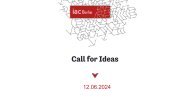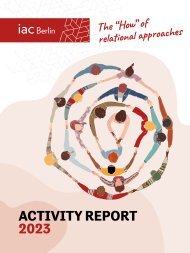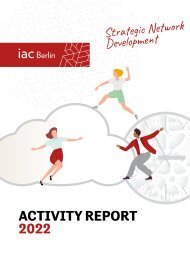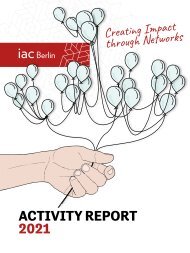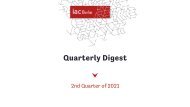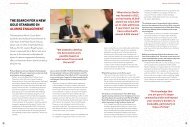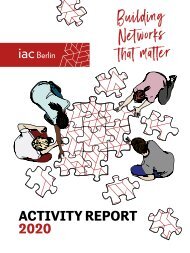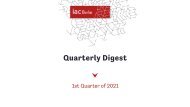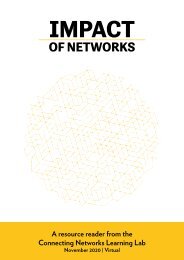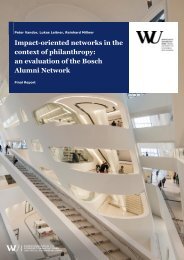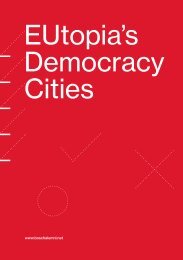Learning Lab: Impact Alliances
In November 2021, iac Berlin convened over 25 members of the Connecting Networks community in Vienna, Austria, for a Learning Lab on “Impact Alliances”. We see high potential in Impact Alliances to drive the substantial changes that are needed to address the complex, interconnected nature of today’s major challenges.
In November 2021, iac Berlin convened over 25 members of the Connecting Networks community in Vienna, Austria, for a Learning Lab on “Impact Alliances”. We see high potential in Impact Alliances to drive the substantial changes that are needed to address the complex, interconnected nature of today’s major challenges.
Create successful ePaper yourself
Turn your PDF publications into a flip-book with our unique Google optimized e-Paper software.
IMPACT<br />
ALLIANCES<br />
A CONNECTING NETWORKS LEARNING LAB<br />
Workshop documentation<br />
November 7-10, 2021 | Vienna, Austria
TABLE OF CONTENTS<br />
Welcome to the <strong>Learning</strong> <strong>Lab</strong>!.............................................................. 3<br />
<strong>Impact</strong> <strong>Alliances</strong>..................................................................................... 4<br />
The Changing Role of Foundations....................................................... 5<br />
<strong>Impact</strong> <strong>Alliances</strong><br />
& Transformation Catalysts................................................................. 7<br />
Case studies: Applying theory to practice......................................... 10<br />
Case study #1: The Social Innovation Generation....................... 11<br />
Case study #2: ANSTOSS DEMOKRATIE....................................... 12<br />
Case study #3: European Cities<br />
for Climate Neutral Construction.................................................. 13<br />
Case Clinics: Peer Coaching.................................................................. 14<br />
Case Clinic: Demokratiewerkstatt................................................. 15<br />
Case Clinic: Bildünger...................................................................... 15<br />
Connecting Networks & iac Berlin....................................................... 16<br />
2
WELCOME TO<br />
THE LEARNING LAB!<br />
In November 2021, iac Berlin convened over 25 members of the Connecting Networks community for a<br />
<strong>Learning</strong> <strong>Lab</strong> in Vienna, Austria, on “<strong>Impact</strong> <strong>Alliances</strong>.” The grand challenges that we face are becoming ever<br />
more complex and interconnected, and developing effective solutions to combat them can not be achieved<br />
alone. Thus, iac Berlin sees <strong>Impact</strong> <strong>Alliances</strong> as an opportunity for philanthropic organizations to take a step<br />
beyond traditional partnerships to bring together cross-sectoral actors behind a shared goal.<br />
At the <strong>Learning</strong> <strong>Lab</strong>, we explored the concepts behind <strong>Impact</strong> <strong>Alliances</strong>, and then delved into practical cases<br />
to examine <strong>Impact</strong> <strong>Alliances</strong> in action. Throughout our time together, the following questions guided our way:<br />
• What is the added value of an <strong>Impact</strong> Alliance compared with traditional partnerships?<br />
• How do we prepare our organizations internally for an <strong>Impact</strong> Alliance?<br />
• How do we align cross-sectoral partners and initiate an <strong>Impact</strong> Alliance?<br />
• What structures are needed to bring about legitimate and effective outcomes?<br />
• How can we capture learnings and monitor impact?<br />
We were joined by Tim Draimin of Community Foundations of Canada, who provided us with a theoretical<br />
background of <strong>Impact</strong> <strong>Alliances</strong> as well as concepts to help bring innovation and systems thinking into the<br />
core of foundations. We then applied the theory to practice with case studies from the Connecting Networks<br />
community. Tim shared his experiences with the Social Innovation Generation in Canada; Annamária Toth<br />
and Vinzenz Himmighofen presented an alliance of five foundations called ANSTOSS DEMOKRATIE;<br />
and Maya Faerch and Luise Fischer introduced us to European Cities for Climate Neutral Construction, a<br />
joint initiative for carbon neutrality. We also visited the House of Philanthropy and ran case clinics with Robin<br />
Gosejohann, Michael Hagemüller, and Christina Purrer, going in depth to explore solutions to challenges that<br />
they’re experiencing in their current projects.<br />
This <strong>Learning</strong> <strong>Lab</strong> was the first in-person meet-up of the Connecting Networks community since the start<br />
of the Corona pandemic, and it proved once again how invaluable it is to be able to connect in person.<br />
Although the lab has ended, we have grown as a community and gathered a great deal of new experience and<br />
knowledge along the way. Whether you were with us in Vienna or are only joining us now, we are pleased to<br />
share our learnings with you.<br />
3
IMPACT ALLIANCES<br />
Our world is changing at a blinding pace, and we are only beginning to understand the complex, interconnected<br />
nature of today’s major challenges—inequality, climate change, political division, etc.—and how<br />
inadequate our traditional solutions are in meeting them. The crises we are facing are daunting, but they are<br />
also an opportunity—an opportunity to question norms, to have profound discussions about rebuilding better,<br />
and to begin working towards fundamental systemic change.<br />
During the pandemic, we saw how quickly<br />
individuals can adapt the way they<br />
live, work, and connect with each other.<br />
Now it is time for foundations to do the same.<br />
With the relative stability of the past few decades, the field of philanthropy has settled into familiar routines.<br />
However, the long established mindset and practices of many foundations are no longer sufficient to combat<br />
the complexity of today’s challenges. It is time for foundations to embrace innovation within their core, to<br />
work with more strategic foresight, and to reimagine the power relationships they have with their partners and<br />
grantees. And above all, it is time for philanthropy to transcend egos and competition, and embrace deep<br />
collaborations that bring actors together across borders and sector lines.<br />
iac Berlin sees high potential in <strong>Impact</strong> <strong>Alliances</strong> to drive these changes. <strong>Impact</strong> <strong>Alliances</strong> unify cross-sectoral<br />
actors so that they can work together more strategically—creating shared visions, aligning activities, pooling<br />
resources, and more. They can start as impactful, coordinated collaborations that significantly enhance the<br />
ability of the alliance to make a far greater impact than if all the partners were to work alone. As the depth of<br />
the collaboration develops, an <strong>Impact</strong> Alliance can begin to frame complex challenges in a systemic perspective<br />
with the ultimate goal of pursuing systems change.<br />
Although <strong>Impact</strong> <strong>Alliances</strong> have high potential, they also come with a unique set of challenges that require<br />
foundations to not only change how they collaborate with partners, but also tests long entrenched mindsets<br />
and practices within their own walls. While direct demands for institutional change will often be met with<br />
resistance, today’s challenges require innovative solutions and there are opportunities to draw that innovative<br />
thinking from the edges of a foundation’s work into its core.<br />
4
THE CHANGING ROLE OF FOUNDATIONS<br />
Tim Draimin, Community Foundations of Canada<br />
1<br />
“At this transitional moment,<br />
the potential for accelerating change goes<br />
beyond just the social and environmental<br />
issues that philanthropy aims to address,<br />
it also applies to the practice<br />
of philanthropy itself.”<br />
Philanthropy is under pressure like never before. The stasis of structures, practices, and power relationships,<br />
which has served as a default for so many decades, is no longer sufficient in the face of today’s staggering<br />
challenges. Foundations must innovate to their core if they are to uphold their duty to society.<br />
However, anyone familiar with such institutions can attest that such fundamental change is a steep uphill<br />
battle—one that more often than not results in failure. An explicit demand for change is often seen as a threat,<br />
and the common reaction is for the institution to “snap back” in defense of the status quo.<br />
To address this internal resistance to innovation, the Monitor Institute by Deloitte borrowed a concept called<br />
Scaling Edges from their colleagues at the Center for the Edge. This approach posits that:<br />
“… the world is constantly changing, driven by a range of powerful social, economic, and political trends<br />
and forces. Alongside these shifts—and, in many cases, in response to them—people and organizations are<br />
continuously experimenting with new ideas and strategies at the edges of any field. Most of these new approaches<br />
remain small and marginal to the mainstream core of practice. But the “Edges” that are particularly<br />
well-aligned with the biggest of the shifts show an outsized potential to grow and to influence and reshape the<br />
core over time.”<br />
Shifts<br />
Powerful social, economic, and political trends and<br />
forces that have the potential to create fundamental<br />
change in the philanthropic landscape.<br />
Edges<br />
Critical frontiers in philanthropy that are particularly<br />
well-aligned with major societal shifts. Edges have an<br />
outsized potential to grow and to influence and reshape<br />
the core of philanthropy over time.<br />
1. The main concepts, definitions, and quotes in this section are drawn from “What’s Next for Philanthropy in the 2020s: Seeing<br />
Philanthropy in a New Light” by Gabriel Kasper, Justin Marcoux, Jennifer Holk & Jeff Morshed of the Monitor Institute by Deloitte.<br />
5
To get a clearer picture of these prevalent trends and forces, the Monitor Institute gathered insights from 200<br />
philanthropic practitioners, donors, board members, experts, and grantees from around the world. They then<br />
identified seven “Big Shifts” in society that define our present and future, and explored what this could mean<br />
for the future of philanthropy and social innovation.<br />
Big Shifts<br />
The Big Shifts open up previously unexplored territories in the field of social change that will force foundations<br />
to innovate their strategies and approaches in order to achieve impact. This creates opportunities for<br />
new innovative practices and mindsets to permeate the Edges of a foundation, moving deeper until they<br />
ultimately influence the practices at the institution’s core. Four Edges were identified that have a high potential<br />
to change fundamental practices that no longer fit the needs of our modern world.<br />
EDGE 4 EDGE 3 EDGE 2 EDGE 1<br />
Rethinking<br />
Philanthropy’s<br />
Role<br />
Balancing<br />
Power<br />
Catalyzing<br />
Leverage<br />
(Re)Designing<br />
the enterprise<br />
How can we be more strategic and impactful?<br />
• Clarity on our guiding mission and impact. Is our strategy systems-focused?<br />
• Shift focus from short-term “projects” to our long-term “missions.”<br />
• Innovation is a core focus—new roles, strategic foresight, & innovation incubation.<br />
• Evolve from branded silos to deep collaboration; overcome our own egos.<br />
• Financial support is only one of our tools. We use networks, narratives, leadership, etc.<br />
How can we share power with grantees and make them partners in change?<br />
• Engage frontline communities in decision-making and ensuring accountability.<br />
• Innovate decentralized governance to enable long-term, mission-driven funding.<br />
• Evaluate with equity in mind; sustainable support for undercapitalized constituencies.<br />
How can we solve complex problems via “big teams,” working across sectors,<br />
mobilizing resources, and deep collaboration?<br />
• Infuse our theory of change with narrative building and social movement thinking.<br />
• Leverage our endowments with program-related investments.<br />
• Embrace new technologies and data; unlock and guide capital.<br />
What are the new social technologies required to be impactful, and how should<br />
foundations adapt themselves?<br />
• Rethink how we onboard teams, cultivate needed skills, exchange with other sectors.<br />
• Innovate more robust knowledge, learning, and evaluation systems.<br />
• Integrate investment functions into programs.<br />
• Develop replicable governance/org. structures with delegated mission platforms.<br />
Which Big Shifts and Edges can you see at your foundation,<br />
and how could they help your foundation drive change?<br />
6
IMPACT ALLIANCES<br />
& TRANSFORMATION CATALYSTS<br />
Tim Draimin, Community Foundations of Canada<br />
If the major challenges of our time demand solutions that are cross-sectoral and<br />
strategically aligned, then social impact initiatives will have to fundamentally change<br />
the way that they work. At present, there are numerous initiatives working on any<br />
given issue, but their efforts are often fragmented and isolated within their own silos.<br />
Philanthropy mirrors this status quo, and although it has experienced a slow evolution<br />
from solitary action towards more collaboration, the pursuit of systemic change will<br />
require it to take a major step forward to embrace <strong>Impact</strong> <strong>Alliances</strong>.<br />
Most foundations can easily locate their current position on the collaboration<br />
spectrum below. Adapted from a model developed by the Tamarack Institute, 2 this<br />
continuum shows how foundations and social impact organizations can fundamentally<br />
change the way they work by shifting relationships away from competition and<br />
towards collaboration.<br />
STAGE<br />
COMPETE COEXIST COMMUNICATE COOPERATE COORDINATE COLLABORATE INTEGRATE<br />
OUTCOME<br />
Opportunity<br />
focused<br />
Awareness<br />
of others<br />
Shared<br />
information<br />
and learning<br />
Shared<br />
program or<br />
service<br />
Shared<br />
program or<br />
service focus<br />
Shared<br />
program or<br />
systems focus<br />
Integrated<br />
outcomes—<br />
program<br />
or systems<br />
focused<br />
PARTNER, CONNECTOR<br />
IMPACT ALLIANCES<br />
CHARACTERISTICS<br />
OF COLLABORATION 3<br />
• Efficiency<br />
• Effectiveness<br />
• Openness & readiness for <strong>Impact</strong> <strong>Alliances</strong><br />
• Innovatively tackling complex challenges<br />
• Moving towards scaling<br />
• Leveraging emergence<br />
Once organizations have reached the “Communicate” stage, the way that they work together begins to take<br />
on different characteristics. In the initial phases of “Communicate” and “Cooperate,” partnerships aim for<br />
collective impact, where the general focus is on jointly implementing a pre-designed program of activities<br />
in order to increase efficiency and impact. Here, a foundation moves from being a mere funder to an active<br />
partner, or uses its position to connect others. However, a long-term, evolving partnership is not expected.<br />
In the “Coordinate” stage, a foundation proactively connects and coordinates its grantees or alumni with<br />
each other (i.e. network building) as well as creating its own connections with other foundations. This is done<br />
with the conscious intention of significantly enhancing the impact that such alliances could achieve together<br />
compared to what the individual organizations could do on their own. The work done at this stage can be very<br />
useful in building capacity for and experimenting with collaborations, in order to better prepare for a systemschange<br />
approach in the future.<br />
The “Collaborate” stage is where deep collaboration begins to happen. Here, strategic alliances develop a<br />
more transformational, shared vision and start framing their programmatic assumptions and planned activities<br />
in systems thinking. These approaches are then fully embraced in the “Integrate” stage, enabling systemschanging<br />
alliances to emerge.<br />
2. Liz Weaver. “The Collaboration Spectrum Revisited.” Tamarack Institute, 2021<br />
3. Adapted from “Partnering for Philanthropic <strong>Impact</strong>.” The Partnering Initiative, 2021<br />
7
<strong>Impact</strong> <strong>Alliances</strong> are relatively new in the field of philanthropy, and such collaborations focus on strategic<br />
alignment and coordination in order to achieve impact. However, getting to this level of deep collaboration<br />
requires that all partners overcome the entrenched desires for ownership, branding, and control—which is no<br />
easy task. A high level of trust, openness, and communication are necessary, but not always easy to achieve.<br />
Often, it is necessary for an <strong>Impact</strong> Alliance to find an external facilitator who can align and coordinate the<br />
various partners.<br />
Sandra Waddock and Steve Waddell from Bounce Beyond call this facilitating role a “transformation catalyst.”<br />
4 This person or entity takes on a catalytic role in bringing together and organizing the array of existing<br />
efforts and activities with the aim of developing a functional <strong>Impact</strong> Alliance. Once it is up and running, the<br />
coordinated activities of the alliance can be much more effective at producing the desired transformative<br />
change.<br />
The transformation catalyst’s role is ...<br />
to bring together an array of efforts so that together<br />
they can emerge or develop new ways to do their<br />
work more effectively—that is, to operationalize the<br />
<strong>Impact</strong> Alliance.<br />
Thus a transformation catalyst clarifies, connects, and amplifies transformational efforts that are already underway,<br />
while making space for experimentation and learning. Four catalytic actions make this alignment and<br />
amplification of efforts possible: seeing, sensemaking, connecting, and radical action and learning. 5<br />
SEEING<br />
SENSEMAKING<br />
CONNECTING<br />
RADICAL ACTION<br />
& LEARNING<br />
Observing to find out what the <strong>Impact</strong> Alliance is about.<br />
Identifying who is doing what, where, and how.<br />
Seeing involves various forms of stakeholder analyses. This helps partners identify<br />
gaps and posssibilities to create more effective action.<br />
Creating a shared and coherent vision among the partners to make new<br />
sense of their actions and alliance.<br />
Sensemaking involves new, powerful narratives that can help draw in additional<br />
partners, raise funds, and create momentum. It also helps participants understand<br />
how to pull together and act in new ways for more effective action.<br />
<strong>Learning</strong> about each other.<br />
Devising new ways to act together more coherently.<br />
Connecting involves aggregrating, aligning and amplifying existing efforts to<br />
boost effectiveness. It also creates a shared set of aspirations, identity, and an<br />
awareness of the alliance’s transformative efforts.<br />
Creating space and a culture for experimentation.<br />
Radical action and learning needs a safe space so that the <strong>Impact</strong> Alliance can<br />
question, explore, analyze assumptions, and experiment in pursuit of transformative<br />
actions. Experimentation is crucial.<br />
4. Sandra Waddock and Steve Waddell. “Transformation Catalysts: Weaving Transformational Change for a Flourishing World for<br />
All.” Cadmus Journal, Volume 4, Issue 4, June 2021<br />
5. Ibid<br />
8
It is important to emphasize that transformation catalysts are not doing the actual impact work themselves.<br />
Instead, they are developing new narratives, structures, and practices in order to align and increase the impact<br />
of existing efforts. Thus the role of a transformation catalyst is best taken on by a person or entity free of institutional<br />
or ideological constraints—thus not an appropriate role for most foundations. However, it is important<br />
that a foundation understands the role and value of a transformation catalyst as well as its own function within<br />
an <strong>Impact</strong> Alliance.<br />
?<br />
?<br />
SYSTEMS CHANGE<br />
How can a funder move along<br />
the collaboration spectrum from<br />
supporting tranformational change<br />
to co-creating it themselves?<br />
?<br />
FIELD BUILDER<br />
Funders have a unique overview<br />
of their fields. How should that be<br />
leveraged?<br />
POWER<br />
If funders rethink their power,<br />
how could they collaborate<br />
differently or more strategically?<br />
What role could your foundation play in an <strong>Impact</strong> Alliance?<br />
What shifts in mindset and practices would your foundation need<br />
to make in order to take on this role?<br />
9
CASE STUDIES:<br />
APPLYING THEORY TO PRACTICE<br />
The <strong>Learning</strong> <strong>Lab</strong> welcomed members of the Connecting Networks community to present their <strong>Impact</strong><br />
<strong>Alliances</strong>, share their experiences, discuss their challenges, and explore solutions. These case studies gave us<br />
the opportunity to take the theories about collaboration and innovating philanthropical practices, and apply<br />
them to real-world situations. A big thank you to all of our case givers!<br />
The following questions 6 served as a guide as we explored each of the cases in depth:<br />
1. What are the outcomes that the alliance wants to achieve?<br />
These goals are often the higher level, more complex goals that can galvanize people, preventing<br />
them from getting stuck on existing, individual strategies.<br />
2. What is the big picture that captures and explains the connections between existing efforts?<br />
The big picture reinforces the idea that complex challenges require interconnected solutions.<br />
3. Where is it more efficient and powerful to work together rather than alone?<br />
By analyzing areas where collaboration makes sense, players are empowered to take on or scale up<br />
solutions together, thus increasing efficiency and the potential for success.<br />
4. What dynamics or structures are in place to enable communication and accountability?<br />
Clarification helps actors stay focused and committed, and ensures that everyone stays on board.<br />
5. What are some examples of outcomes, achievements, or learnings?<br />
6. Adapted from Irby and Boyle. “Aligning Collective <strong>Impact</strong> Initiatives.” Stanford Social Innovation Review, 2014<br />
10
CASE STUDY #1:<br />
THE SOCIAL INNOVATION GENERATION<br />
Tim Draimin, Community Foundations of Canada<br />
Overview<br />
The Social Innovation Generation was a national platform that supported the creation of a social innovation<br />
culture in Canada between 2007 and 2017. The McConnell Foundation, the University of Waterloo, MaRS,<br />
and the Plan Institute all came from different sectors—philanthropy, academia, and the private and social<br />
sectors—but recognized that the conventional ways of supporting and scaling social innovation kept hitting<br />
the same roadblocks.<br />
Key question:<br />
How do we maintain alignment while creating space for emergence?<br />
When the alliance was first coming together, they were able to articulate a shared mission and objectives.<br />
However, they didn’t have a definitive plan for developing solutions, but rather assumed that with the right<br />
people and enough resources a generative alliance would form that could innovate around the issue and the<br />
desired outcomes would emerge. This didn’t happen. They couldn’t reach agreements, and the frustration<br />
grew.<br />
Approach<br />
The alliance was built on a strong set of existing relationships between colleagues, peers, and friends, so there<br />
was already a culture of trust, resilience, and an openness to learn. They decided to bring in a transformation<br />
catalyst, who could help illuminate the way forward and create an environment in which their relationships and<br />
ideas could grow.<br />
The partners found a common path to their vision, made a commitment to learn together, and agreed that all<br />
should have the freedom to experiment. This opened up the space for them to redefine their understanding<br />
of social innovation within a systems thinking framework. This widened their perspective on how they could<br />
effect change and inspired experimentation with new kinds of interventions. They developed an array of<br />
diverse, but strategically aligned activities, including building tools, creating educational programs, organizing<br />
events to diffuse ideas into society, and more.<br />
Ultimately, Social Innovation Generation recognized that its true value was quite different from what it had<br />
originally envisioned, and that by building the field, their work had made a significant contribution to the widespread<br />
adoption of social innovation in Canada.<br />
To find out more, please visit www.sigeneration.ca.<br />
11
CASE STUDY #2:<br />
ANSTOSS DEMOKRATIE<br />
Annamária Toth, European Forum Alpbach Foundation, & Vinzenz Himmighofen, iac Berlin<br />
Overview<br />
ANSTOSS DEMOKRATIE, which can be loosely translated as Impetus for Democracy, is an <strong>Impact</strong> Alliance<br />
of five foundations that focuses on the challenges facing democratic culture and social cohesion in the<br />
German-speaking regions of Europe. The alliance was initiated by the European Forum Alpbach Foundation<br />
(AT), the ERSTE Stiftung (AT), the Mercator Foundation (CH), Stiftung Mercator (DE) and the Robert<br />
Bosch Stiftung (DE) after they discovered that they shared many overlapping issues and decided to explore<br />
ways in which they could strategically collaborate to combat them.<br />
Key question:<br />
How can organizations collaborate more effectively across sectors and<br />
borders?<br />
As five established institutions coming together in an <strong>Impact</strong> Alliance, they had to find ways to be able to<br />
work together effectively and align their different expectations, assets, and approaches. Also, as the alliance is<br />
working on a transnational level, they needed to identify overarching thematic challenges as well as areas of<br />
intervention where collaborative efforts—their own as an alliance as well as social impact organizations in the<br />
field—could have the most impact.<br />
Approach<br />
In their preliminary discussions, it quickly became clear that they would need a neutral, external facilitator<br />
(i.e. transformation catalyst) to coordinate the process, facilitate communication, and manage their shared<br />
resources. iac Berlin stepped into that role, and together they created an agile, decentralized structure that<br />
would provide a clear framework for their collaboration without getting overly bureaucratic. An emphasis was<br />
put on facilitating clear communication to ensure that everyone was on board as well as developing a culture<br />
that is open to trial-and-error.<br />
As a first exploratory activity, the alliance talked with diverse stakeholders active in the field in order to better<br />
understand the context in each country and define key issues around democracy that transcended borders.<br />
They then identified areas where their interventions and collaborative efforts could be the most powerful, and<br />
called for organizations in the field to reach across borders and sector lines to explore these areas.<br />
Building on the ongoing explorations and collaborations with (potential) partner organizations, the alliance<br />
is currently designing paths to integrate lessons learned into a shared strategy, widening the alliance to new<br />
partners, clarifying what new roles need to be created, and more.<br />
To find out more, please visit www.anstossdemokratie.net.<br />
Planning<br />
Planning &<br />
Emergence<br />
Probing &<br />
Divergence<br />
Emergence<br />
Emergence &<br />
Resonance<br />
Resonance<br />
Convergence<br />
12
CASE STUDY #3:<br />
EUROPEAN CITIES FOR<br />
CLIMATE NEUTRAL CONSTRUCTION<br />
Luise Fischer, EIT Climate-KIC, & Maya Faerch, Laudes Foundation<br />
Overview<br />
A few years ago, EIT Climate-KIC started the Healthy Clean Cities Program in 15 European cities.<br />
Meanwhile, the Laudes Foudation had decided to invest in its Built Environment Strategy. Critical<br />
prerequisites for a collaboration between the two included highly aligned values and a shared mission to<br />
achieve a climate-neutral, inclusive, just, and circular society. Together, they created the initiative European<br />
Cities for Climate Neutral Construction (EU CINCO), which mobilizes a broad coalition of city leaders,<br />
citizen groups, and businesses to advance circular and bio-based, carbon-neutral, building practices in urban<br />
regeneration projects in Milan and Madrid. The learnings and approaches developed through EU-CINCO<br />
can then be shared and scaled in cities across Europe.<br />
Key question:<br />
How do we achieve systemic impact?<br />
The collaboration foresees five steps in achieving systemic impact: 1) select a committed challenge owner,<br />
such as a city or government agencies; 2) work on clear, ambitious targets, such as carbon neutrality by year X;<br />
3) identify the main systems that need to change; 4) design deliberate portfolios of innovation interventions;<br />
5) learn continuously and keep feedback loops short.<br />
Approach<br />
The partners chose to step beyond traditional foundation-grantee conventions, establishing a relationship<br />
based on equality, mutual respect, and shared appreciation for the assets that each brought to the table.<br />
Through much communication, they co-created the approach, scope and objectives for their joint venture.<br />
Given that climate change is a complex challenge with multiple, non-linear factors influencing each other, the<br />
partners agreed that continuous learning and sensemaking as well as a more holistic set of evaluation metrics<br />
would be essential.<br />
The alliance has a full agenda in the coming months, including a co-developed communications strategy,<br />
an evaluation, and the dissemination of lessons learned. While the initial phase is planned to last two years,<br />
Climate-KIC and the Laudes Foundation look forward to an extension of their collaboration in pursuit of a<br />
sustainable future.<br />
To find out more, please visit www.climate-kic.org.<br />
13
CASE CLINICS:<br />
PEER COACHING<br />
As part of the <strong>Learning</strong> <strong>Lab</strong>, we embarked on an impact expedition to the House of Philanthropy for a round<br />
of case clinics. Robin Gosejohann of the Institute for the Danube Region and Central Europe presented<br />
Demokratiewerkstatt (Democracy Workshop), and Christina Purrer of the Sinnbildungsstiftung and Michael<br />
Hagemüller of Ashoka shared Bildünger (loosely translated as Cultivating Education) an <strong>Impact</strong> Alliance of<br />
the Sinbildungsstiftung. After a short presentation of the respective programs, the group engaged in generative<br />
dialogue to explore solutions to the challenges presented by the case giver.<br />
Later, participants at the <strong>Learning</strong> <strong>Lab</strong> also had the opportunity to hold their own case clinics, presenting and<br />
discussing their challenges in smaller, more intimate groups.<br />
Thank you to all of our case givers for sharing!<br />
Case Clinic Format 7<br />
Intention: Helping each other see a current challenge from a different perspective through deep listening<br />
and asking generative questions.<br />
1. Presenting the case:<br />
• What’s the context?<br />
• Current situation: What key challenges are you up against?<br />
• Intention: What future are you trying to create?<br />
• Help: What question do you want to focus on?<br />
2. Clarifying the case: Asking questions, but not yet discussing.<br />
3. Stillness: Silent reflection on the ideas, feelings, and questions inspired by the case.<br />
4. Mirroring: Peers share their reflections, and the case giver shares what resonates and clarifies her or<br />
his question for the group.<br />
5. Generative dialogue: Offering new perspectives and insights, but not trying to fix or give advice.<br />
6. Closing remarks: Case giver reflects on the session and any gained insights.<br />
7. Based on the case clinic format by the Presencing Institute.<br />
14
CASE CLINIC:<br />
DEMOKRATIEWERKSTATT<br />
Robin Gosejohann, Institute for the Danube Region and Central Europe (IDM)<br />
Demokratiewerkstatt (Democracy Workshop) is a program that empowers school children to learn about the<br />
democratic process through civic education workshops at their national parliament and active engagement<br />
with their representatives. The program was developed by the Austrian parliament and has established a solid<br />
track record over the last seven years, during which it was introduced in two additional national parliaments.<br />
Since 2020, IDM has been the implementing partner for launching the program in other European countries.<br />
To establish the program in a new location, IDM and the Austrian parliament identify appropriate partners in<br />
the national parliament and civil society, and look for funding to support the post-implementation phase of<br />
the program.<br />
Some of the challenges that IDM has found while trying to scale this program are:<br />
• The political context is different in each country, and certain processes can’t be easily replicated.<br />
When we start in a new country, how can we create a safe space where the convened stakeholders<br />
can begin to exchange?<br />
• All of the stakeholders come from different institutions with very different needs and decisionmaking<br />
hierarchies. How can we align them behind a shared vision?<br />
CASE CLINIC:<br />
BILDÜNGER<br />
Christina Purrer, Sinnbildungsstiftung & Michael Hagelmüller, Ashoka<br />
Bildünger—which can be loosely translated as Cultivating Education—is a joint initiative of the Sinnbildungsstiftung<br />
(a collaboration of 14 philanthropic organizations), Ashoka, and the state-funded Foundation for<br />
Innovation in Education. The overall goal of Bildünger is to innovate the education system, with particular<br />
focus on boosting 21st century skills and smoothing the transition between educational levels. Through an<br />
annual mapping and open call for proposals, Bildünger selects projects that are scalable and have the potential<br />
to change education in Austria at a systemic level. The project teams also become part of the Bildünger<br />
community, where members can network, exchange, and take part in community events.<br />
Some of the challenges that Bildünger is currently working on include:<br />
• How can we build a bridge to the formal education system in order to scale innovative ideas?<br />
• What is a private foundation’s role in creating a solid education system?<br />
• How do we find alignment with other private foundations?<br />
• What are ways that we can shift how we learn and collect more feedback from kids and youth?<br />
Are you interested in submitting your initiative for a case clinic with the<br />
Connecting Networks community? Contact: andreas.obser@iac-berlin.de<br />
15
CONNECTING NETWORKS<br />
& IAC BERLIN<br />
The <strong>Learning</strong> <strong>Lab</strong> was designed by iac Berlin for the Connecting Networks community. Connecting Networks<br />
offers a range of activities and learning formats that provide space for peer exchange and learning on topics<br />
ranging from network building and collaboration, to strategy development and social innovation.<br />
Activities & <strong>Learning</strong> Formats<br />
<strong>Learning</strong> <strong>Lab</strong>s: 2-3 day workshops to explore<br />
and advance dialogue around key themes and<br />
emerging issues.<br />
Strategy Retreats: 2-3 day gatherings to jointly<br />
advance strategies, share learnings, expand skills,<br />
and solve challenges with peers.<br />
Side Events at International Conferences:<br />
Panel discussions and round tables organized<br />
in parallel to large conferences to encourage<br />
thinking together outside the box and building the<br />
periphery of our networks.<br />
Online Resource Site: Curated literature, tools,<br />
and perspectives on networks in philanthropy, incl.<br />
practical cases and research studies.<br />
www.iac-berlin.org/resources/tools-resources<br />
Peer Connections: Facilitated introductions<br />
and supported partnership-building between<br />
community members with common interests,<br />
complementary activities, or shared ambitions.<br />
<strong>Impact</strong> Sessions: 1-2 day case clinics or peer<br />
exchange, on-site or online.<br />
Connecting Networks<br />
Connecting Networks is more than just a<br />
program—it’s a community of peers from more<br />
than 50 organizations across Europe, all coming<br />
with a wide variety of experience and networks at<br />
various stages of development.<br />
We are shaping our journey together, contributing<br />
our questions, expertise, practices, and support<br />
to move us all forward. Connecting Networks is<br />
facilitated, hosted, and supported by a diverse<br />
team of leading thinkers and doers, who share<br />
their insights and expertise with their peers.<br />
iac Berlin<br />
iac Berlin was founded by the Robert Bosch<br />
Stiftung to support the development of networks<br />
for social impact. As a Do & Think Tank, we<br />
partner with foundations, academia, public<br />
institutions, and non-profit organizations. We<br />
advise on alumni work, develop practical solutions<br />
for the design of impact-oriented networks, and<br />
initiate new forms of collaboration.<br />
iac Berlin has a unique approach to building<br />
networks and communities. We think strategically,<br />
work on assumptions, test them in minimum<br />
viable product settings, and integrate the lessons<br />
learned into successfully running networks and<br />
projects.<br />
iac Berlin coordinates the Bosch Alumni Network<br />
and incubates <strong>Impact</strong> <strong>Alliances</strong> such as the Global<br />
Diplomacy <strong>Lab</strong>, ANSTOSS DEMOKRATIE, and<br />
SDG Places.<br />
16
The <strong>Learning</strong> <strong>Lab</strong> was a collective effort of:<br />
Abdul Dube, Visual Confidence • Visual recording & graphics<br />
Alexis Eremia, freims • Workshop design & facilitation<br />
Andreas Obser, iac Berlin • Workshop design<br />
Céline Hopster, iac Berlin • Logistics & event management<br />
Darius Polok, iac Berlin • Workshop design<br />
Hinnerk Hansen, freims • Workshop design & facilitation<br />
Stephanie Don, freelancer • Documentation, text, & layout<br />
Tobias Gerber, iac Berlin • Communications<br />
Special thanks to ...<br />
... Tim Draimin for his invaluable expertise.<br />
... all case givers and participants for their<br />
contributions and curiosity.<br />
... <strong>Impact</strong> Hub Vienna for hosting us.<br />
... the Robert Bosch Stiftung and the BMW<br />
Foundation Herbert Quandt for their<br />
financial support.<br />
If you are interested in joining the Connecting Networks community<br />
or exchanging with us on the role of networks in philanthropy, please contact:<br />
darius.polok@iac-berlin.org<br />
If you want to learn more about building stronger networks, organizations,<br />
and communities, you can find a variety of resources on these topics at:<br />
www.iac-berlin.org<br />
Follow us on LinkedIn to stay up to date on recent developments, insights,<br />
and upcoming events: www.linkedin.com/company/iacberlin<br />
iac Berlin<br />
Linienstr. 65a, 10119 Berlin, Germany<br />
www.iac-berlin.org




